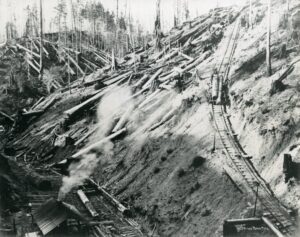In studying history, one of my favorite discoveries is how creativity and ingenuity solved problems, like moving really BIG things. Incline railways were one such invention. These rail lines had nicknames for their many parts – they were “sidehill railroads” using “gravity systems” to run “log slide engines” and “dropping machines.” Basically, what the systems accomplished was moving logs or lumber in really steep terrain.

When logging started on the North Coast, oxen and horses pulled logs on skid roads to sawmills, or to rivers where logs could be floated to the mill. Next came Donkey Engines, stationary steam engines on skids with rotary gears and cable attachments. Logs could then be mechanically pulled to one spot next to a railroad where they were loaded to go to a mill.
Railroads were great inventions where land was flat and the grade gentle, but the North Coast was full of mountains. It was expensive to blast tunnels or design switchback tracks to gain elevation and darned if those redwoods didn’t like to grow on ridge tops. Rising costs and steep terrains led timber barons to consider a new sort of railroad. To save miles of track building, engineers figured out that they could lay out tracks that just went straight up hill for miles. Inspired by tramways designed for mining underground they adapted the idea for logging. By the 1890’s strong wire cable rope was available for the job.
The solution? Engineers imagined a system to lower flat cars loaded with logs down a very steep railroad grade while empty cars were pulled back to the top, where logs were waiting. Put a special Donkey Engine or a stationary locomotive on top of the ridge, invent a good braking system, and find a crew unafraid of heights. Workers joked it was a rare sensation to find oneself standing up while lying down hanging on for dear life as they rode the empty flatcars up the hill.
As a concession to the laws of physics, if a grade was steeper than 35% the crews chained the logs down, so they didn’t fall off the rail cars headfirst. There were bumpers on each end of the flat car beds. This was a high maintenance operation as there was a lot of friction on the wire cables. A broken line sent logs and men flying through the air. Incline railways were used from the 1890s to the 1940s. Their routes are invisible to us today as timber has regrown and covered the incline track beds.
The mightiest incline ever built in the West was developed near Yosemite. The starting point was the Merced River and the end was 3,100’ uphill. It took 8,300’ of spooled cable and a 76% grade to get there. In later years there were inclines longer in length but never that steep. Grades of 60% and 70% were not unusual on inclines in Oregon and Washington. Can you imagine how big a spool of wire needed to be to wind up 1,300’ of steel cable? They were massive.
By Aptos, down by Santa Cruz, the Loma Prieta Lumber Company had an incline with a 600’ gain in elevation in one mile. Know that ski resort in the Sierra at Incline Village? Sierra Nevada Lumber Company started an incline railway there to lift cars of finished lumber 1,800’ to the Sierra crest so they could be slid eastward down to Nevada.
Eight different lumber companies in Humboldt County had 28 inclines and one became a tourist attraction. California Barrel Company had a 5,400’ incline that crossed what is now Highway 299 on a trestle. Cars could pull off the road near Lord Ellis Summit to watch loaded flatcars flashing by overhead in the 1930s. There were eight inclines south of Scotia that were from 3,200’ to 6,700’ long. Bear Harbor had one 1,900’ long that rose 600’ at a grade of 31%. Its complicated design had rails separating into four tracks at midpoint to allow ascending and descending cars to pass one another.
Back here in Mendocino County, the Caspar Lumber Company had four inclines which were called Bouten’s Tramway. Two were on the north fork of Caspar Creek and near Berry Gulch, another was on the north side of Big River near McGuire’s Hill close to Highway 20, and the fourth incline was near Parlin Fork on Three Chop Ridge.
Mendocino City had an incline, too, but not as steep as most of these. It transported processed materials like lumber, shingles, and pickets from the sawmill down on Big River Flat up to the drying and storage yards along the bluffs around the Point’s shipping area south of Main Street. These tracks were purportedly the first railroad in California.
To learn more about incline railways, try reading (if you can find these out-of-print jewels) “Logging Railroads of the West” by Kramer Adams, “Redwood Lumber Industry” by Lynwood Carranco, and “Mallets on the Redwood Coast: Caspar Lumber Company” by Ted Wurm. The Kelley House Archives have some of these titles.